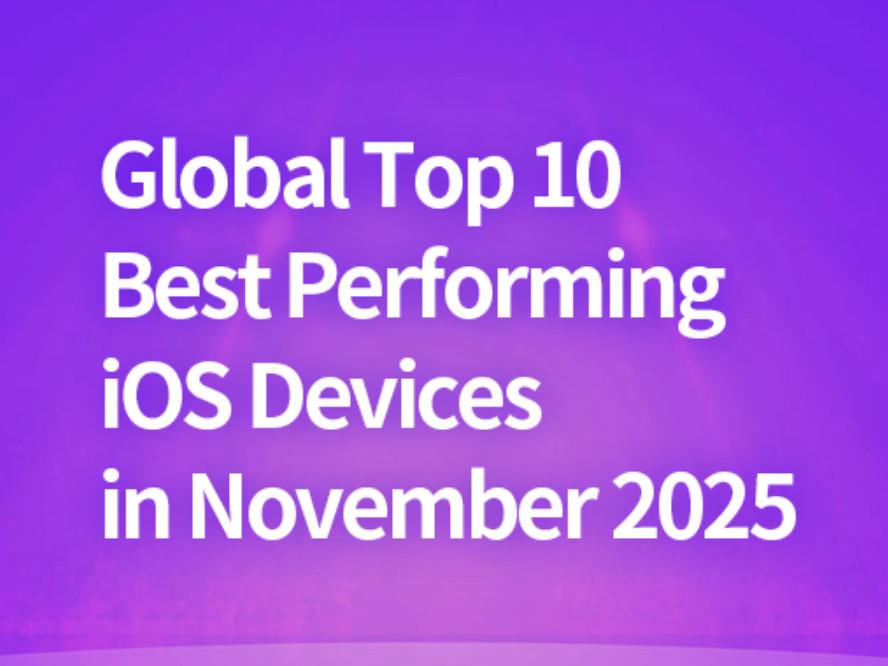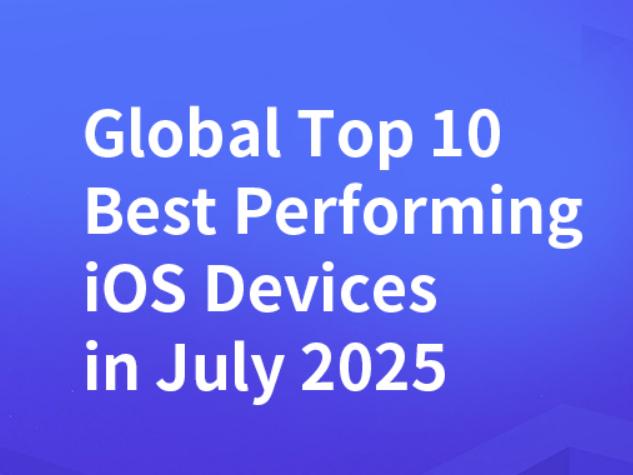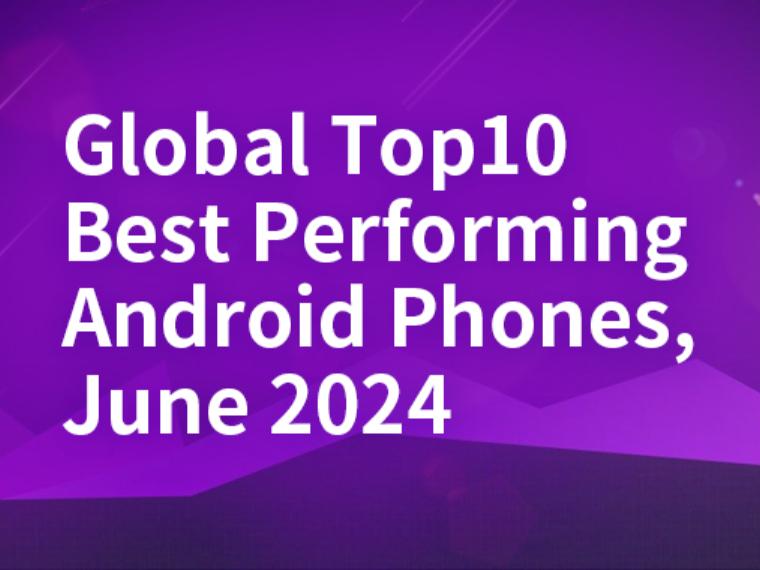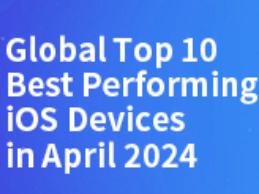Global Top 10 Best Performing Android Phones, September 2020
In October 2020, the second half of Androidphone configuration competition has officially started. This month Apple hasofficially launched its first 5G phones with a more powerful A14 chip. Moreinterestingly, Qualcomm officially announced this week that it would hold theannual technical summit in December and launch the new-generation flagship SoCSnapdragon 875 thereon. The phone performance competition seems not to endforever.
Let's see what changes happened to the Androidphone performance ranking list in September.
This time, the data was collected for aperiod from September 1, 2020 to September 30, 2020; the results in the rankinglist are average scores instead of the highest scores; and there are more than1,000 pieces of information on single phone model. The data was calculatedbased on Antutu V8. If any single phone model has several memory capacity versions,then its version of the highest memory capacity shall prevail.
1. Flagship Phones
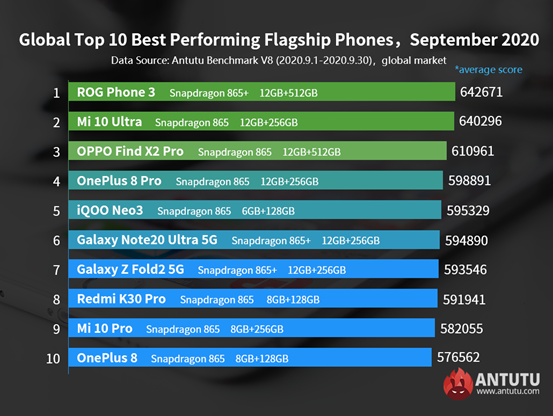
In this performance ranking list, Asus' ROGPhone 3 still stands at the first place with an average score of 642,671 inSeptember. As usual, it is the first phone model to ship with flagshipSnapdragon SoC "+" this year. Historically, Asus gaming phones havealways stood at the first place in the performance ranking for consecutivemonths since their respective launch.
This Asus ROG Phone 3 is equipped with a6.59-inch AMOLED display screen which supports the 144Hz refresh rate, the275Hz touch response, and HDR 10+ and achieves a response time of 1ms and aresolution ratio of 2340×1080. There is a transparent area on the back of this phone,so we can see its internal cooling fin. The cooling fin of ROG Phone 3 is 7times bigger than that of the last generation and covers the main coolingparts, achieving a more efficient cooling capacity.
Most interestingly, this phone is alsoequipped with one 6,000mAh battery and two Type-C interfaces. You can hold thisphone in whatever direction and use it while charging it, which is a uniquehighlight of the gaming phone.
The product ranking second is Mi 10 Ultra,the latest flagship phone of Xiaomi with a Snapdragon 865 processor. Itscomprehensive score is 640,296, just more than 2,000 points lower the Asus ROGPhone 3 which ranks No. 1. Obviously, what is the most crucial is not theprocessor performance, but the degree of optimization by the manufacturer.
This phone performs very well with many newtechnologies exclusively developed by Xiaomi (e.g.: Write Turb and HDB softwaresupports), so such a result is not surprising.
Besides, it should be noted that MIUI 12embedded in Mi 10 Extreme Commemorative Edition has a function named GameTurbo4.0, by which users can control the GPU frequency of a single game and choosethe degree of SoC performance for this game manually. For users who likeplaying games and pursue high performance, such a function is the icing on thecake. We hope that more mobile phones will have similar functions in thefuture.
The popular OPPO Find X2 Pro stands at thethird place with an average score of 610,961 in September, much lower thanthose of the products ranking first and second. It is also the last phone witha score of over 600,000 in the ranking list. Since its launch in this March, ithas been completely ranking at the top in terms of configuration andperformance, with an up-to-date advanced screen. It can be seen that OPPO FindX2 Pro is very powerful.
Following them, the seven phone models arerespectively OnePlus 8 Pro (average score: 598,891), iQOO Neo3 (average score:595,329), Galaxy Note20 Ultra 5G (average score: 594,890), Galaxy Z Fold2 5G(average score: 593,546), Redmi K30 Pro (average score: 591,941), Mi 10 Pro(average score: 582,055), and OnePlus 8 (average score: 576,562).
2. Mid-range Phones
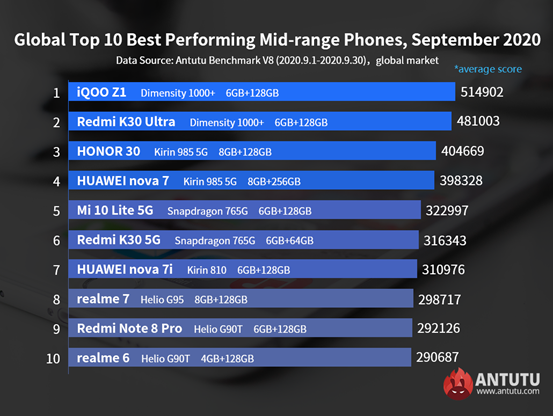
Compared with the only processor -Snapdragon 865 Series in the flagship phone ranking, there are variousprocessors in the mid-range phone ranking, including phone models of Qualcommas well as MediaTek and Hisilicon Kirin.
In the mid-range phone ranking, iQOO Z1ranks No. 1 with an average score of 514,902. It is the first phone to shipwith MediaTek Tianji 1000+ processor. The phone model ranking second is RedmiK30 Ultra with the same processor, and its average score is 481,003.
What's very interesting is that MediaTek Dimensity1000+ is positioned as a flagship 5G SoC of MediaTek but used in mid-range phonesby terminal manufacturers due to some long-term problems concerning brand andmanufacturer. Therefore, this phone has just been included in the mid-rangephone ranking list, despite its flagship SoC. The score of iQOO Z1 that ranksNo. 1 in this list is also much lower than the lowest score among those ofphones with Snapdragon 865. Therefore, MediaTek needs to make more efforts todevelop the flagship SoC.
Honour 30 stands at the third place in thisranking. Its Kirin 985 SoC, a processor independently developed by Huawei, issecond only to Kirin 990 5G presently, but its performance has been furtherimproved when compared with the performance of Kirin 820.
And it's said that Kirin 985 and Kirin 820are the same chip in nature, but the latter has two GPU cores shielded andKirin 985 is completely open. That's exactly toothpaste squeezing.
Following them, the seven phone models arerespectively Huawei nova 7 (average score: 398,328), Mi 10 Lite 5G (averagescore: 322,997), Redmi K30 5G (average score: 316,343), HUAWEI nova 7i (averagescore: 310,976), realme 7 (average score: 298,717), Redmi Note 8 Pro (averagescore: 292,126), and realme 6 (average score: 290,687).
October is the second half of the launchseason for Android phones every year. Huawei Mate40 and OnePlus 8T both will belaunched in this month, after which this ranking list will change again. Themost striking is certainly what result will Huawei Kirin 9000 processorachieve. It is of great significance as the last-generation self-developedprocessor of Huawei.
5nm will be a keyword for the nextgeneration of processors which will achieve further better performance andlower power consumption. The foreseeable and more powerful terminal devices aredrawing near.


